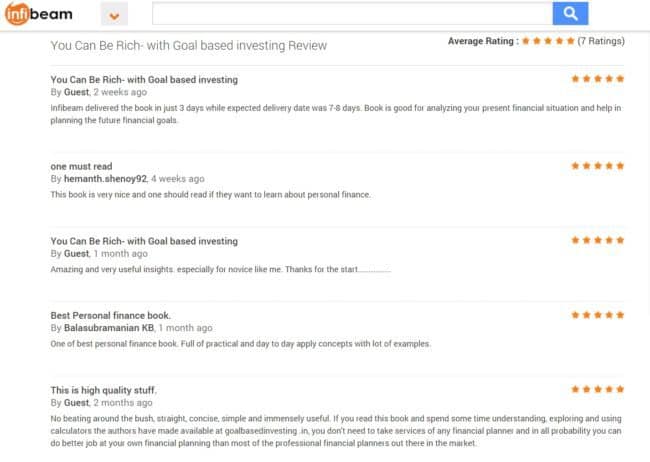Last Updated on October 8, 2023 at 1:40 pm
The systematic transfer plan (STP) is a way for an asset management company to lock into some “business”, just as jewel shop does with a “gold scheme”. It can be used to withdraw from one mutual fund to either generate regular income or transfer that money to another fund (typically equity) in the name of “reducing risk” relative to a lump sum investment. In this post, I present some Lump sum vs STP data.
Before we begin, it is important to recognise choosing a STP over a lump sum is mainly for psychological reasons than for gains or returns. Many equity investors have trouble handling losses. If they dump 1 Lakh today and find that the market rose by 4% the next day, they act like a kid in a candy store (that is what it was being in AIFW yesterday as the election results came out). However, if the market falls by 4% the next day, they are going to be consumed by regret. So for such people, an STP is a better idea.
Of course, one must first be able to define what a lump sum is, and this changes with time. I have covered these aspects before: How to invest a lump sum in an equity mutual fund?. I believe the simplest way to invest a lump sum is to get rid of it by manually investing over a few months (less than a year) if lump sum investing is scary. In this post, I present some data for those who would like to see some.
Important: Lump sum or STP, once the entire amount is invested, the risk associated with either method is the same. The entire amount will be subject to the ups and downs of the market.
Join 32,000+ readers and get free money management solutions delivered to your inbox! Subscribe to get posts via email! (Link takes you to our email sign-up form)
🔥Want to create a complete financial plan? Learn goal-based investing? Exclusive access to our DIY tools? Increase your income with your skills? Enjoy massive discounts on our robo-advisory tool & courses! 🔥
In April 2013, I had published a Comprehensive Mutual Fund Investment Mode Comparator. This my first Excel Macro and by current standards, not as comprehensive. I compared Lump sum vs. STP for all possible 3,5,7,10,15,20 and 25-year periods between 1980 and 2012 using historical Sensex monthly data and showed that
- Both lump sum and STP modes have a similar probability of loss irrespective of duration.
- The chance of STP doing better than lump sum mode is only 25-35% for all durations.
A 3 year period is a bit too long for an STP. And for just a few months, annualised returns are not relevant. One year is just passable. Two years is okay for analysis, but not practical (although some do it! Waste of time and money). Anyways for what it is worth, I have updated the above study for just 1Y and 2Y periods.
Suppose I have Rs. 1000 and I consider this as a lump sum.
(a) I invest it today and calculate the corpus and return after 1Y or 2Y (Lump sum investing)
(b) I invest in equal instalments over 1Y or 2Y and then calculate the corpus and returns. (STP Investing)
Depending on market conditions, (a) may be better than (b) or vice versa. The problem with a SIP is that calculating the XIRR (annualised return) may not always be possible. If the process ends in a loss, then the XIRR function often returns 0%. This is not an actual return, but an inability of the function to estimate returns. See more: IRR/XIRR: Limitations of Calculating Complex Cash Flow Returns
When tested with 433 1-Year STP periods (separated by a month) from March 1980 to March 2017, as many as 130 STP returns were 0% (or indeterminate). So they were excluded for comparison.
Among the rest of the periods, a lump sum investment had a higher return than a STP 52.5% of the times. And when the corpus was compared, the Lump sum corpus was higher 65.8% of the times.
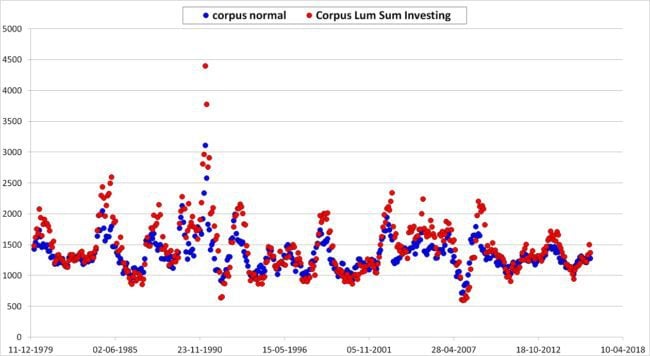
When tested over 420 2-Year STP periods, the Lumpsum corpus was higher 72.9% of the times and with a higher return 44.6% of the times (excluding 0% XIRR). So there is no proof that the STP is better than a lump sum.
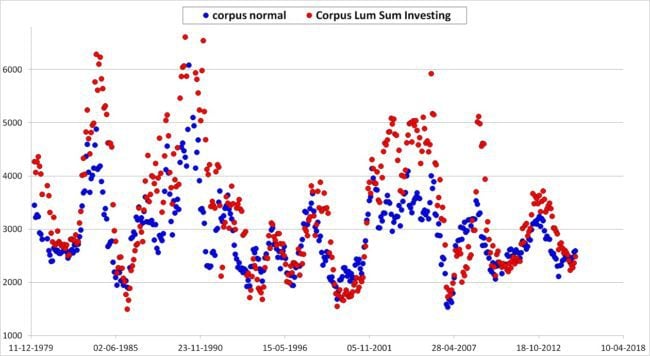
It is okay to say that an STP is a calmer way of investing a lump sum. There is no argument here. The amcs probably see it as a way of retaining the lump sum for longer and hence promote it.
It is not okay (rather baseless) to claim that an STP will do better than a lump sum.
I think either a lump sum or a pretty short STP (over 3-4 months) should do.
Some History
Systematically investing the same sum each month is called dollar cost averaging. There many studies that have compared lump sum investing and dollar cost averaging and have pretty much concluded the same: Lump sum is superior to STP in terms of financial instrument performance (not investor performance).
This is a summary: Dollar Cost Averaging—Myth vs. Reality
Does Dollar Cost Averaging Make Sense For Investors?
Nobody gains from Dollar Cost Averaging
A note on the suboptimality of the Dollar Cost Averaging as an investment policy
Please Note: The above studies compare a lump sum investment and dollar cost averaging or STP. They are not talking about a SIP.
Ask Questions with this form
If you have generic questions on personal finance, you can ask them using this form, and I will respond to them next week. I welcome tough questions. Please do not ask for investment advice. Before asking, please search the site if the issue has already been discussed. Thank you.
New Delhi DIY Investor Workshop April 23rd 2017
Register for the New Delhi DIY Investor Workshop April 23rd 2017
You Can Be Rich Too With Goal-Based Investing
Happy to announce that my book with PV Subramanyam has been selected as part of Amazon Best Reads Mar 2017. now 50% off. Thank you for your support and trust. If you have not yet got the book, check out the reviews below and use the links to buy.
Reader Quotes:
Gift it to your Friends and Relatives whom you care more. Already follower of Pattu and Subra’s forum. Ordered 4 more copies to give gift to my friends and eagerly waiting to read
The best book ever on Financial Freedom Planning. Go get it now!
Your first investment should be buying this book
The (nine online) calculators are really awesome and will give you all possible insights
Thank you, readers, for your generous support and patronage.
Amazon Hardcover Rs. 199. Now 50% OFF.
Kindle at Amazon.in (Rs. 307)
Google Play Store (Rs. 307)
Infibeam Now just Rs. 307 24% OFF.
If you use a mobikwik wallet, and purchase via infibeam, you can get up to 100% cashback!!
Bookadda Rs. 344. Flipkart Rs. 359
Amazon.com ($ 3.70 or Rs. 267)
Google Play Store (Rs. 244.30)
- Ask the right questions about money
- get simple solutions
- Define your goals clearly with worksheets
- Calculate the correct asset allocation for each goal.
- Find out how much insurance cover you need, and how much you need to invest with nine online calculator modules
- Learn to choose mutual funds qualitatively and quantitatively.
More information is available here: A Beginner’s Guide To Make Your Money Dreams Come True!
What Readers Say
🔥Enjoy massive discounts on our courses, robo-advisory tool and exclusive investor circle! 🔥& join our community of 7000+ users!
Use our Robo-advisory Tool for a start-to-finish financial plan! ⇐ More than 2,500 investors and advisors use this!
Track your mutual funds and stock investments with this Google Sheet!
We also publish monthly equity mutual funds, debt and hybrid mutual funds, index funds and ETF screeners and momentum, low-volatility stock screeners.



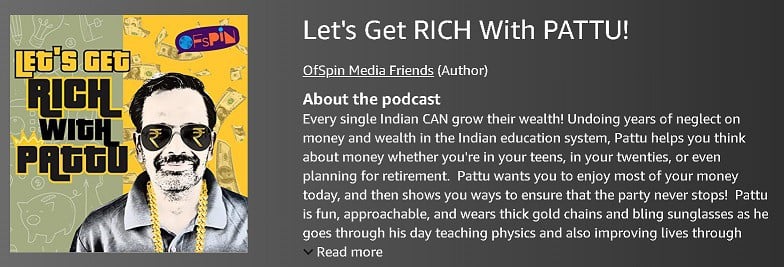

- Do you have a comment about the above article? Reach out to us on Twitter: @freefincal or @pattufreefincal
- Have a question? Subscribe to our newsletter using the form below.
- Hit 'reply' to any email from us! We do not offer personalized investment advice. We can write a detailed article without mentioning your name if you have a generic question.
Join 32,000+ readers and get free money management solutions delivered to your inbox! Subscribe to get posts via email! (Link takes you to our email sign-up form)
About The Author
 Dr M. Pattabiraman(PhD) is the founder, managing editor and primary author of freefincal. He is an associate professor at the Indian Institute of Technology, Madras. He has over ten years of experience publishing news analysis, research and financial product development. Connect with him via Twitter(X), Linkedin, or YouTube. Pattabiraman has co-authored three print books: (1) You can be rich too with goal-based investing (CNBC TV18) for DIY investors. (2) Gamechanger for young earners. (3) Chinchu Gets a Superpower! for kids. He has also written seven other free e-books on various money management topics. He is a patron and co-founder of “Fee-only India,” an organisation promoting unbiased, commission-free investment advice.
Dr M. Pattabiraman(PhD) is the founder, managing editor and primary author of freefincal. He is an associate professor at the Indian Institute of Technology, Madras. He has over ten years of experience publishing news analysis, research and financial product development. Connect with him via Twitter(X), Linkedin, or YouTube. Pattabiraman has co-authored three print books: (1) You can be rich too with goal-based investing (CNBC TV18) for DIY investors. (2) Gamechanger for young earners. (3) Chinchu Gets a Superpower! for kids. He has also written seven other free e-books on various money management topics. He is a patron and co-founder of “Fee-only India,” an organisation promoting unbiased, commission-free investment advice.Our flagship course! Learn to manage your portfolio like a pro to achieve your goals regardless of market conditions! ⇐ More than 3,000 investors and advisors are part of our exclusive community! Get clarity on how to plan for your goals and achieve the necessary corpus no matter the market condition is!! Watch the first lecture for free! One-time payment! No recurring fees! Life-long access to videos! Reduce fear, uncertainty and doubt while investing! Learn how to plan for your goals before and after retirement with confidence.
Our new course! Increase your income by getting people to pay for your skills! ⇐ More than 700 salaried employees, entrepreneurs and financial advisors are part of our exclusive community! Learn how to get people to pay for your skills! Whether you are a professional or small business owner who wants more clients via online visibility or a salaried person wanting a side income or passive income, we will show you how to achieve this by showcasing your skills and building a community that trusts and pays you! (watch 1st lecture for free). One-time payment! No recurring fees! Life-long access to videos!
Our new book for kids: “Chinchu Gets a Superpower!” is now available!


Must-read book even for adults! This is something that every parent should teach their kids right from their young age. The importance of money management and decision making based on their wants and needs. Very nicely written in simple terms. - Arun.Buy the book: Chinchu gets a superpower for your child!
How to profit from content writing: Our new ebook is for those interested in getting side income via content writing. It is available at a 50% discount for Rs. 500 only!
Do you want to check if the market is overvalued or undervalued? Use our market valuation tool (it will work with any index!), or get the Tactical Buy/Sell timing tool!
We publish monthly mutual fund screeners and momentum, low-volatility stock screeners.
About freefincal & its content policy. Freefincal is a News Media Organization dedicated to providing original analysis, reports, reviews and insights on mutual funds, stocks, investing, retirement and personal finance developments. We do so without conflict of interest and bias. Follow us on Google News. Freefincal serves more than three million readers a year (5 million page views) with articles based only on factual information and detailed analysis by its authors. All statements made will be verified with credible and knowledgeable sources before publication. Freefincal does not publish paid articles, promotions, PR, satire or opinions without data. All opinions will be inferences backed by verifiable, reproducible evidence/data. Contact information: To get in touch, use this contact form. (Sponsored posts or paid collaborations will not be entertained.)
Connect with us on social media
- Twitter @freefincal
- Subscribe to our YouTube Videos
- Posts feed via Feedburner.
Our publications
You Can Be Rich Too with Goal-Based Investing
 Published by CNBC TV18, this book is meant to help you ask the right questions and seek the correct answers, and since it comes with nine online calculators, you can also create custom solutions for your lifestyle! Get it now.
Published by CNBC TV18, this book is meant to help you ask the right questions and seek the correct answers, and since it comes with nine online calculators, you can also create custom solutions for your lifestyle! Get it now.Gamechanger: Forget Startups, Join Corporate & Still Live the Rich Life You Want
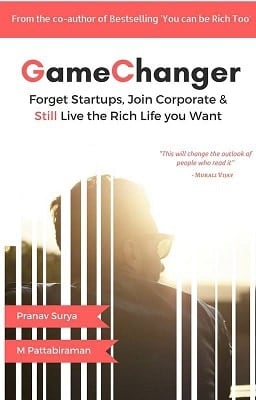 This book is meant for young earners to get their basics right from day one! It will also help you travel to exotic places at a low cost! Get it or gift it to a young earner.
This book is meant for young earners to get their basics right from day one! It will also help you travel to exotic places at a low cost! Get it or gift it to a young earner.Your Ultimate Guide to Travel
 This is an in-depth dive into vacation planning, finding cheap flights, budget accommodation, what to do when travelling, and how travelling slowly is better financially and psychologically, with links to the web pages and hand-holding at every step. Get the pdf for Rs 300 (instant download)
This is an in-depth dive into vacation planning, finding cheap flights, budget accommodation, what to do when travelling, and how travelling slowly is better financially and psychologically, with links to the web pages and hand-holding at every step. Get the pdf for Rs 300 (instant download)

